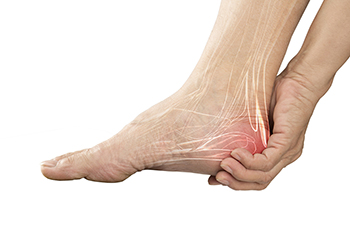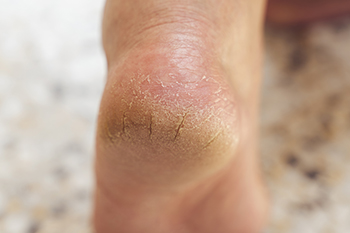Connect With Us
Blog
Items filtered by date: October 2024
Types of Broken Ankles

Broken ankles are common injuries that can involve various fractures of the bones in the ankle joint, primarily the tibia, fibula, and talus. A fracture can occur from a sudden twist, fall, or impact, leading to symptoms such as intense pain, swelling, bruising, and difficulty bearing weight. There are several types of ankle fractures, including stable fractures, where the bones remain aligned, and unstable fractures, where the bones shift out of place. Stress fractures can also develop over time due to repetitive impact. Treatment depends on the type and severity of the fracture. Minor fractures may require rest, while more serious fractures often necessitate immobilization with a cast or splint. In some cases, surgery may be needed to realign the bones. If you suspect an ankle fracture, it is suggested that you schedule an appointment with a podiatrist for a thorough evaluation and tailored treatment plan.
Broken ankles need immediate treatment. If you are seeking treatment, contact Patricia Mcilrath, DPM from Health One Podiatry. Our doctor can provide the care you need to keep you pain-free and on your feet.
Broken Ankles
A broken ankle is experienced when a person fractures their tibia or fibula in the lower leg and ankle area. Both of these bones are attached at the bottom of the leg and combine to form what we know to be our ankle.
When a physician is referring to a break of the ankle, he or she is usually referring to a break in the area where the tibia and fibula are joined to create our ankle joint. Ankles are more prone to fractures because the ankle is an area that suffers a lot of pressure and stress. There are some obvious signs when a person experiences a fractured ankle, and the following symptoms may be present.
Symptoms of a Fractured Ankle
- Excessive pain when the area is touched or when any pressure is placed on the ankle
- Swelling around the area
- Bruising of the area
- Area appears to be deformed
If you suspect an ankle fracture, it is recommended to seek treatment as soon as possible. The sooner you have your podiatrist diagnose the fracture, the quicker you’ll be on the way towards recovery.
If you have any questions, please feel free to contact our offices located in Reading and Rittenhouse Square, PA . We offer the newest diagnostic and treatment technologies for all your foot care needs.
Plantar Heel Pain

Plantar heel pain, often associated with conditions like plantar fasciitis, is a common issue that can significantly impact daily activities. It typically manifests as a sharp pain in the heel, especially with the first steps in the morning or after prolonged periods of sitting. This discomfort can result from several factors, including overuse, wearing improper footwear, obesity, and tight calf muscles. Activities that put excessive strain on the heel, such as running or standing for long periods of time can worsen the condition. Treatment options vary, but they often include exercises that can strengthen the foot and improve flexibility. Custom orthotics may also be recommended to provide support and distribute pressure evenly. If you are experiencing persistent heel pain, it is important to seek professional help. It is suggested you schedule an appointment with a podiatrist to receive a proper diagnosis and personalized treatment plan to get you back on your feet comfortably.
Plantar fasciitis can be very painful and inconvenient. If you are experiencing heel pain or symptoms of plantar fasciitis, contact Patricia Mcilrath, DPM from Health One Podiatry. Our doctor can provide the care you need to keep you pain-free and on your feet.
What Is Plantar Fasciitis?
Plantar fasciitis is the inflammation of the thick band of tissue that runs along the bottom of your foot, known as the plantar fascia, and causes mild to severe heel pain.
What Causes Plantar Fasciitis?
- Excessive running
- Non-supportive shoes
- Overpronation
- Repeated stretching and tearing of the plantar fascia
How Can It Be Treated?
- Conservative measures – anti-inflammatories, ice packs, stretching exercises, physical therapy, orthotic devices
- Shockwave therapy – sound waves are sent to the affected area to facilitate healing and are usually used for chronic cases of plantar fasciitis
- Surgery – usually only used as a last resort when all else fails. The plantar fascia can be surgically detached from the heel
While very treatable, plantar fasciitis is definitely not something that should be ignored. Especially in severe cases, speaking to your doctor right away is highly recommended to avoid complications and severe heel pain. Your podiatrist can work with you to provide the appropriate treatment options tailored to your condition.
If you have any questions, please feel free to contact our offices located in Reading and Rittenhouse Square, PA . We offer the newest diagnostic and treatment technologies for all your foot care needs.
Causes and Symptoms of Trench Foot

Trench foot is a condition that arises when the feet are exposed to cold, damp environments for prolonged periods. Historically associated with soldiers in World War I, it can occur in anyone who spends extended time in wet conditions. The primary cause is the combination of cold temperatures and moisture, which leads to reduced blood flow and tissue damage. Symptoms include swelling, redness, and a tingling sensation in the feet. As the condition progresses, blisters may form, and the skin can become numb. If left untreated, trench foot can result in severe complications, including infection or even tissue death. Awareness of this condition is vital, especially for people working in wet and cold environments. If you have this foot condition, it is suggested that you promptly visit a podiatrist who can treat trench foot, and guide you on effective prevention methods.
Foot Pain
Foot pain can be extremely painful and debilitating. If you have a foot pain, consult with Patricia Mcilrath, DPM from Health One Podiatry. Our doctor will assess your condition and provide you with quality foot and ankle treatment.
Causes
Foot pain is a very broad condition that could be caused by one or more ailments. The most common include:
- Bunions
- Hammertoes
- Plantar Fasciitis
- Bone Spurs
- Corns
- Tarsal Tunnel Syndrome
- Ingrown Toenails
- Arthritis (such as Gout, Rheumatoid, and Osteoarthritis)
- Flat Feet
- Injury (from stress fractures, broken toe, foot, ankle, Achilles tendon ruptures, and sprains)
- And more
Diagnosis
To figure out the cause of foot pain, podiatrists utilize several different methods. This can range from simple visual inspections and sensation tests to X-rays and MRI scans. Prior medical history, family medical history, and any recent physical traumatic events will all be taken into consideration for a proper diagnosis.
Treatment
Treatment depends upon the cause of the foot pain. Whether it is resting, staying off the foot, or having surgery; podiatrists have a number of treatment options available for foot pain.
If you have any questions, please feel free to contact our offices located in Reading and Rittenhouse Square, PA . We offer the newest diagnostic and treatment technologies for all your foot care needs.
Are You Suffering From Ingrown Toenails?
When Should Babies Start Wearing Shoes?

Determining when babies should start wearing shoes and choosing the right type is essential for their development. Babies typically do not need shoes until they begin walking, which is usually around nine to 12 months. Before this milestone, barefoot time is ideal as it allows for natural foot development and strengthens the muscles. Once a baby starts walking, soft, flexible shoes are recommended to protect their feet while allowing natural movement. Opt for shoes with a wide toe box, soft soles, and breathable materials to ensure comfort and proper growth. Avoid stiff or heavily cushioned shoes, as they can restrict foot development. Properly fitted shoes should support their feet without being too tight or loose, and frequent checks are necessary as their feet grow rapidly during this stage. If you have concerns about your child’s foot development and what type of shoes are best to wear, it is suggested that you consult a podiatrist who can provide you with the knowledge you are seeking.
The health of a child’s feet is vital to their overall well-being. If you have any questions regarding foot health, contact Patricia Mcilrath, DPM of Health One Podiatry. Our doctor can provide the care you need to keep you pain-free and on your feet.
Tips for Keeping Children's Feet Healthy
- Make sure their shoes fit properly
- Look for any signs of in-toeing or out-toeing
- Check to see if they have Clubfoot (condition that affects your child’s foot and ankle, twisting the heel and toes inward) which is one of the most common nonmajor birth defects.
- Lightly cover your baby’s feet (Tight covers may keep your baby from moving their feet freely, and could prevent normal development)
- Allow your toddler to go shoeless (Shoes can be restricting for a young child’s foot)
- Cut toenails straight across to avoid ingrown toenails
- Keep your child’s foot clean and dry
- Cover cuts and scrapes. Wash any scratches with soap and water and cover them with a bandage until they’ve healed.
If you have any questions, please feel free to contact our offices located in Reading and Rittenhouse Square, PA . We offer the newest diagnostic and treatment technologies for all your foot care needs.
Painful Cracked Heels

Cracked heels, or heel fissures, occur when the skin on the heels becomes dry and thickened, leading to painful splits or cracks that can sometimes become infected. This condition often arises from a combination of factors, such as prolonged standing, wearing open-back shoes, and exposure to harsh weather conditions. Symptoms include visible cracks in the heel skin, which can become painful, especially when walking. The affected area may also appear dry, rough, sometimes inflamed, and ensuring proper foot hygiene can prevent infection. For persistent or severe cases of heel fissures, it is suggested that you schedule an appointment with a podiatrist for a comprehensive evaluation and treatment plan.
Cracked heels are unsightly and can cause further damage to your shoes and feet. If you have any concerns, contact Patricia Mcilrath, DPM from Health One Podiatry. Our doctor can provide the care you need to keep you pain-free and on your feet.
Cracked Heels
Cracked heels appear unappealing and can make it harder for you walk around in sandals. Aside from looking unpleasant, cracked heels can also tear stockings, socks, and wear out your shoes. There are several methods to help restore a cracked heel and prevent further damage.
How Do You Get Them?
Dry skin is the number one culprit in creating cracked heels. Many athletes, walkers, joggers, and even swimmers suffer from cracked heels. Age and skin oil production play a role to getting cracked heels as well.
Promote Healing
Over the counter medicines can help, especially for those that need instant relief or who suffer from chronic dry feet.
Wear Socks – Wearing socks with medicated creams helps lock in moisture.
Moisturizers – Applying both day and night will help alleviate dryness which causes cracking.
Pumice Stones – These exfoliate and remove dead skin, which allows for smoother moisturizer application and better absorption into the skin.
Change in Diet
Eating healthy with a well-balanced diet will give the skin a fresh and radiant look. Your body responds to the kinds of food you ingest. Omega-3 fatty acids and zinc supplements can also revitalize skin tissue.
Most importantly, seek professional help if unsure how to proceed in treating cracked heels. A podiatrist will help you with any questions or information needed.
If you have any questions, please feel free to contact our offices located in Reading and Rittenhouse Square, PA . We offer the newest diagnostic and treatment technologies for all your foot care needs.

